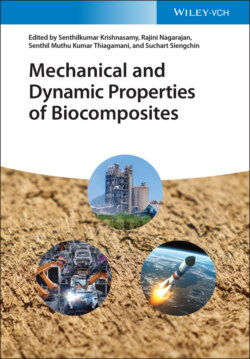Читать книгу Mechanical and Dynamic Properties of Biocomposites - Группа авторов - Страница 19
1.4.1.4 Coconut/Cork FRP Hybrid Composites
ОглавлениеA natural coconut fiber, also known as coir, is usually extracted from coconut trees. These trees are mainly grown in tropical regions of Asian countries, such as Vietnam, India, and Thailand [4]. Cork fiber is usually obtained from cork oak trees (Quercus suber). There is a specific species of the tree from whose bark the cork fiber is harvested. The cork oak tree is a renewable resource, as new cork bark regrows naturally [4].
Hybrid composites containing high‐density polyethylene (HDPE) with reinforcements of cork powder and short coconut fibers that were randomly distributed was prepared by Fernandes et al. [30]. The interfacial bonding and compatibility between the matrix and fiber was improved by maleic anhydride, a coupling agent (CA). Their results showed 27% and 47% rise in elastic moduli and tensile strengths of the coconut/HDPE/cork hybrid composites, respectively (Table 1.6), when compared with the cork/HDPE composite. Also, they observed that using CA resulted in enhancement of the elongation at break and tensile behaviors of the hybrid composites. As a recommendation for better mechanical responses of the cork‐based composites, 10 wt.% of short coconut fibers and 2 wt.% of CA were proposed.
Table 1.6 Mechanical behaviors of banana/sisal, coconut/cork, coir/silk, corn husk/kenafm and cotton/jute FRP hybrid composites.
Source: Nguyen et al. [4]. © 2017, Elsevier.
| Hybrid biocomposites | Fiber ratio (by weight or volume) | Flexural modulus (GPa) | Flexural strength (MPa) | Tensile modulus (GPa) | Tensile strength (MPa) | Impact strength (kJ/m2) |
|---|---|---|---|---|---|---|
| Banana/sisal | 100 : 0 | 8.920 | 57.33 | 0.642 | 16.12 | 13.25 |
| 75 : 25 | 9.025 | 58.51 | 0.662 | 17.39 | 15.57 | |
| 50 : 50 | 9.130 | 59.69 | 0.682 | 18.66 | 17.90 | |
| 25 : 75 | 9.235 | 60.87 | 0.703 | 19.93 | 20.22 | |
| 0 : 100 | 9.340 | 62.04 | 0.723 | 21.20 | 22.54 | |
| Coconut/cork | 10 : 44 : 44 : 2 (wt.% of coconut/cork/HDPE/coupling agent) | — | — | 0.599 ± 0.02 | 20.4 ± 0.3 | — |
| Coir/silk | Alkali treatment | |||||
| 10 mm fiber | — | 39.53 | — | 15.01 | — | |
| 20 mm fiber | — | 45.07 | — | 17.24 | — | |
| 30 mm fiber | — | 42.02 | — | 16.14 | — | |
| Corn husk/kenaf | 0 : 30 (PLA 70 wt.%) | — | — | 2.117 | — | — |
| 15 : 15 (PLA 70 wt.%) | — | — | 1.547 | — | — | |
| 30 : 0 (PLA 70 wt.%) | — | — | 1.221 | — | — | |
| Cotton/jute | 23.7 : 76.3 (jute fabric type III) | |||||
| Test angle, 0° | 9.9 ± 0.8 | 136.7 ± 4.0 | 7.1 ± 0.3 | 59.4 ± 1.7 | 9.3 ± 0.9 | |
| Test angle, 45° | 8.4 ± 0.7 | 84.6 ± 4.7 | 4.6 ± 0.1 | 21.1 ± 1.4 | 7.5 ± 1.0 | |
| Test angle, 90° | 7.2 ± 0.7 | 58.3 ± 5.4 | 4.1 ± 0.1 | 14.6 ± 0.5 | 5.5 ± 1.0 |
HDPE = high‐density polyethylene.
